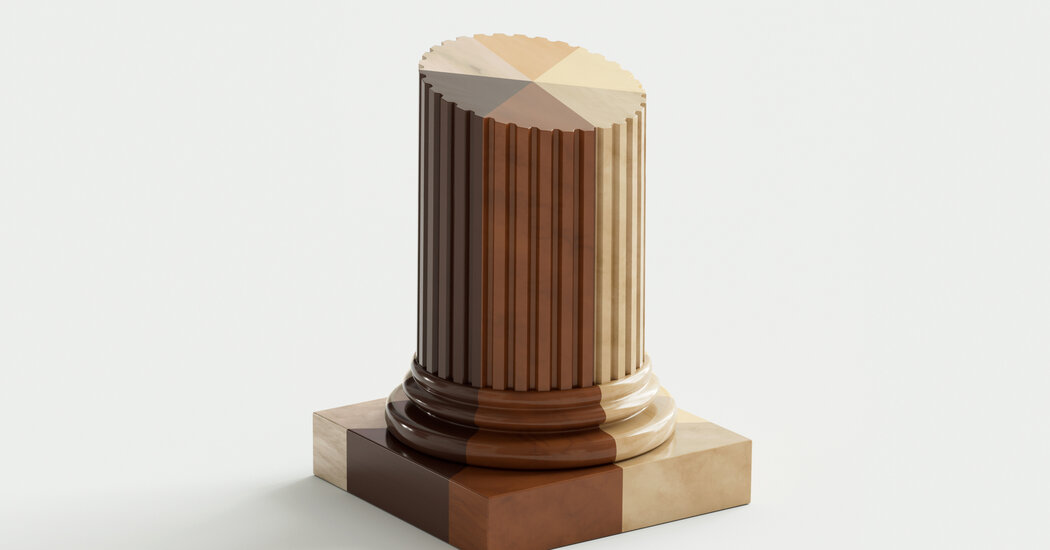Not long ago, in the cinema, I found myself trying to focus on Timothée Chalamet’s charming portrayal of a young Willy Wonka, arriving penniless in a new city. What drew my attention instead was the population he encountered there. The first person to greet him was a joyful British Indian. Soon we met a cute orphan sidekick, played by a Black American actor, and the chief of police, played by a biracial American. The vaguely Mitteleuropean city Wonka had come to — Viennese shops, Italian architecture, English language — was a happy melting pot: All races seemed to coexist without race meaning anything. The story was set in a fantastical past, but its cast looked like a utopian 21st-century London, with actors of British and Caribbean and Asian backgrounds all stirred together. The Oompa-Loompas, described by Roald Dahl as a pygmy people found “in the very deepest and darkest part of the African jungle where no white man had ever been before,” were played by Hugh Grant.
Across the arts, we now see so many worlds that never existed. David Copperfield is played by Dev Patel. Marvel’s Norse pantheon includes a Black deity. The hit Netflix series “Bridgerton” depicts a version of Regency England ruled by a Black queen and an anachronistically multiracial royal court.
When you see these examples gathered, they’re often followed by some complaint of a world gone mad with inclusion. In Britain, for instance, there was some outrage when the protagonist of an otherwise faithful Agatha Christie adaptation was revised to be a Nigerian immigrant. But the problem, for viewers, isn’t wokeness run amok; it’s the incoherence of the world we are watching. We see an African man solving crimes in a rural English village of the 1950s, as the sun sets on the empire — yet his race is barely mentioned or considered and never makes any material difference in his experience.
You might call this kind of defiantly ahistorical setting the Magical Multiracial Past. The bones of the world are familiar. There is only one change: Every race exists, cheerfully and seemingly as equals, in the same place at the same time. History becomes an emoji, its flesh tone changing as needed.
And yet something is off, something that makes these stories impossible to get lost in. You can never fully envision the Magical Multiracial Past without having to mentally take apart the entire scaffolding of world history. “Bridgerton” is set before Britain abolished slavery, an institution that apparently exists, largely unmentioned, in the world of the show. What, precisely, are the rules of a world in which a Black queen reigns over a British Empire that sanctions the enslavement of Black people?
Included, But Erased
The impulse behind such choices surely comes from a good place. Storytellers are struggling with how to approach a historically white canon and a set of well-worn genres (like the period costume drama) whose characters would, in reality, be almost exclusively white. They are wary of simply omitting all the other ethnicities that are part of the modern, multiracial West, either as performers or, potentially, as viewers. Neither do they want to tell stories in which nonwhite people must always appear as servants, or victims, or issues.
The Magical Multiracial Past is one optimistic solution to this conundrum. We want to include everyone in our storytelling, but we are not always prepared to change the kinds of stories we tell. So we simply suspend disbelief; we imagine that everyone who is currently a part of our Anglophone culture has been there, a valued and equal participant, all along
Thus have all of us, from around the globe, been retconned into the history of the West. Now we can watch ourselves speak languages we did not speak in rooms where we were unlikely to have been welcome. We are included, but our actual history is erased. We seldom see the stories of nonwhite people who, like my ancestors, lived on their home soil, or the complex stories of nonwhite people in the West in centuries past. The world’s history is reduced from many to one.
Some feel that this sort of wishful casting can help model how a multiethnic society should function. But whom, precisely, does it benefit? It is convenient that the Magical Multiracial Past allows white viewers to watch white protagonists move through history without anyone having to think uncomfortable thoughts; indeed, the people of the Magical Multiracial Past get along better than we do in the present. I don’t think this is principally for the benefit of those of us who aren’t white. I think instead of a line from James Baldwin: “A great deal of one’s energy,” he once wrote, “is expended in reassuring white Americans that they do not see what they see.”
And maybe this is why, while I struggle to cope with these revised pasts intellectually, I also think they tend to fail emotionally, deep down in the places a good story is meant to reach. The tales are often boring, marked by a well-meaning blandness — by an avoidance of uncomfortable truths.
Seeing the Canon Afresh
There are alternatives to this fantasy. One obvious option is that, rather than trying to fit the modern world into the canon, we could expand the canon itself. It’s not difficult to tell stories from more parts of the world. In literature, the writer Marlon James has worked to make his Dark Star trilogy, inspired by ancient African folklore, avoid becoming a “European fantasy novel in brown face.” Children’s entertainment offers stories like Disney’s “Moana,” immersed in Polynesian culture, and “Iwájú,” set in a future Lagos. All sorts of films find ways to acknowledge nonwhite people in Western history or to dramatize their histories elsewhere.
Or we can see the canon afresh. You can keep the cowboy but tear it to shreds, as Mel Brooks did with the story of a Black sheriff in “Blazing Saddles.” Or you can rebuild it, as Quentin Tarantino did in “Django Unchained” by making the hero a former slave. (Tarantino called the cruel slave owners of his film a “grotesque parody of European aristocracy,” a far more interesting take on the concept of royalty, in my view, than pretending to be a royal myself.) There is also humor here. A good joke in “Hot Tub Time Machine 2” is rooted in an unacknowledged truth of time-travel stories: It’s mostly people who look like Marty McFly who want to go all that far into American history.
There is nothing wrong with dreaming of things that never were, but we shouldn’t use that power to pretend bad things didn’t happen. Personally, I’m drawn to a good counterfactual. I find myself thinking often about a 1995 film called “White Man’s Burden.” Written and directed by Desmond Nakano, a third-generation Japanese American, the movie places John Travolta in an alternate America in which Black people hold all the power and white people live in drug-filled ghettos. It opens with a lavish, all-Black dinner party at which the head of the table muses about whether white people are, as a race, beyond saving — a reversal heightened by the fact that this bad guy is played, with tremendous charisma, by the civil rights icon Harry Belafonte.
Art should explore our shared history and try to make sense of it. Consider the recent uproar over Google’s artificial-intelligence model, so trained to produce “colorblind” images that it would offer the ridiculous: the founding fathers as Native American men, racially diverse Nazis. Google’s trillion-dollar team of scientists tried to solve the problems of racism by ignoring them and thereby found their own way to the Magical Multiracial Past. It’s striking to think that humans working in the arts have been making the same choices. The past is messy, and depicting it can be unsettling. But understanding that is what separates us from robots.
Kabir Chibber is a writer and filmmaker based in New York. He last wrote for the magazine about the prophetic power of the film “Demolition Man.”









